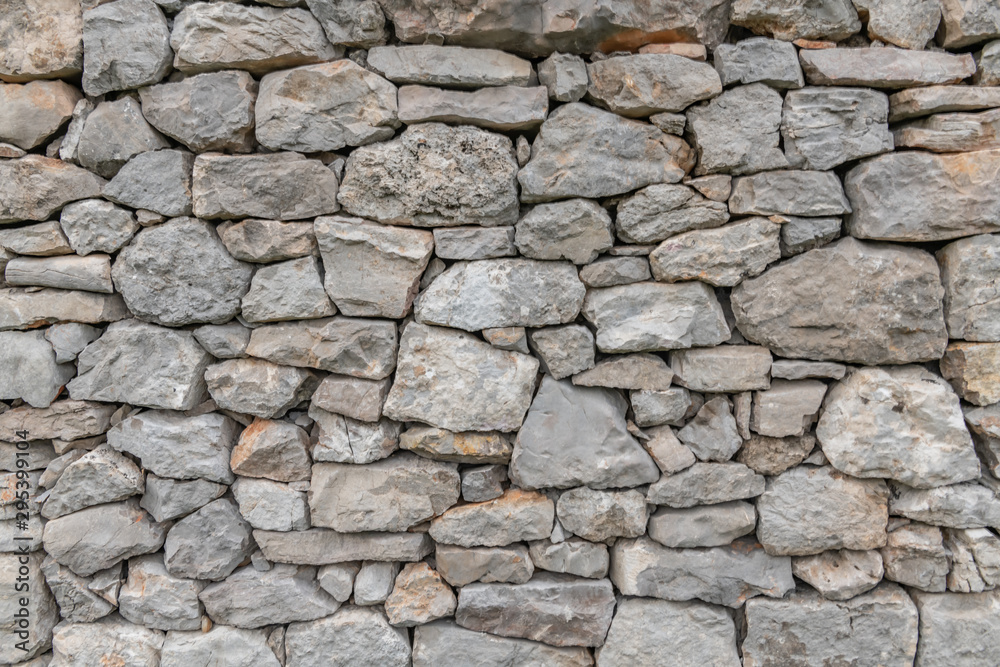A stone is a piece of rock. It is a mass of hard, compacted mineral. The word is often used to mean a small piece of rock.
The word “stone” also refers to natural rock as a material, especially a building material. Natural stones used as building material include granite, marble and sandstone. Manufactured, artificial products, such as concrete or clay bricks, are not stone.
Stone takes a while to heat up, and stays hot for a while. It does not conduct electricity well Stone was one of the first materials used to make tools and buildings. It is a very sturdy material. It is less affected by weather than wood or brick. Depending on the type of rock, stone weathers away much more slowly. A stone in the river is reshaped by the water and sediment flowing around it. Stones can be used as primitive weapons. A person can throw it at an enemy or animal, or use it to cause more damage in hand-to-hand combat.A stone is larger than a grain of sand, gravel or pebbles. A boulder is a large rock or stone.
Common Characteristics of Historic Stone
Due to its strength and durability, stone has been a key element in all types of buildings and structures since the beginning of architecture and construction. Not only is it a particularly useful element, but the wide variety of colors and textures of stonework found all over the world gives rise to an extensive list of various aesthetics. Many common characteristics of historic stone fall from this commonality of strength and beauty among different types of stone.
Since stone is difficult to transport due to size and weight, stones will often be sourced relatively close to the area in which the building is to be constructed. Consequently, specific characteristics of stone will vary depending upon the region in which the stone is found. For example, igneous rock is found near volcanic activity and differs from sedimentary rock which is found near water sources. Accordingly, the different types of stone which come from igneous rock will have different specific characteristics than the stones which are by nature sedimentary.
However, there are general qualities which are characteristic of all stone. Some common characteristics include appearance, weight, durability, strength, hardness, porosity, and resistance to fire and electricity. It is important to take these and other characteristics into account when constructing or restoring a historic building. Misunderstanding stonework can result in more harm than good when it comes to restoration or new design.
Common Characteristics
Appearance:- When it comes to historic buildings, beauty is just as important as strength. For this reason, it is vitally important to choose a stone that will fit with the building’s overall appearance. Color, warm or cool tones, texture, and pattern are all important factors that play a part in choosing the right stone.
Weight:-A stone’s weight affects its strength and durability. Although heaviness makes transportation difficult, it is a distinguishing factor of stone which cannot be found in other architectural elements. It can withstand immense weathering and wear in a way that wood or other architectural elements cannot. Granite is among the heaviest stones which has been used throughout the centuries.
Durability:-The durability of stone is primarily due to its compactness and homogeneity. This means that the minuscule particles of the stone are very close together and generally all the particles are of the same material. The compactness of the stone results in little room for absorbing liquids which is ideal since absorption will cause cracking and other damage to stone.
Strength:-Due to its durability and weight, stone is the strongest material used in the construction world. Structures made with a high percentage of stone last hundreds of years or longer and are capable of withstanding severe weathering and earthquakes.
Hardness:-Another useful characteristic is stone’s hardness which again is due to its high compactness and enables the stone to resist damage from scratching or chipping. This quality gives stone a brand-new appearance years after it is built.
Porosity:- Stones should not be porous since water and other liquids can seep in and cause the stone to expand and crack. Low porosity results in little absorption and therefore lasting and sturdy historic structures.
Resistance:- Stone is also highly resistant to fire and electricity due to its compactness. This immensely adds to its lasting value and durability.
Since stone is so valuable in the architecture world, the importance of identifying and caring for historic stone cannot be emphasized enough. A few simple measures taken to conserve or prevent wear and cracking will go a long way and will be worth the time, money, and effort for years to come.
Canning is highly experienced in cleaning, conserving, and restoring historic stonework. Some examples of the company’s work include the restoration of stone and marble at the Barker Library Dome, MIT as well as St. Mary’s Chapel in Boston which involved removing the surface soot and dirt, carbon stains, and efflorescence without damaging or altering the stone’s appearance or strength.


